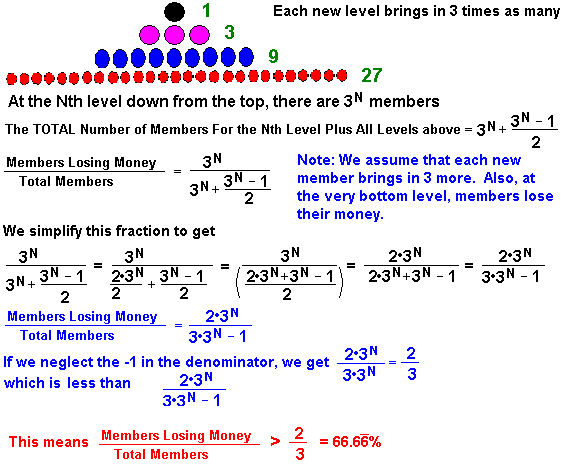The Mathematics of a Pyramid Scheme - The Scam Explained
There are many "get rich quick" pyramid schemes on the internet.
Some are illegal "pyramid schemes" (scams), and some are barely legal
"business propositions" that bear a striking resemblance to an illegal
pyramid scheme.
The Simplest Pyramid Scheme - A Chain Letter Scam
An example of the simplest form of a pyramid scheme would involve
Person A sending a letter to 2 other people (Level B) requesting them
to send $1 back, and to then send letters out to 2 other people (Level
C) requesting a dollar. So Person A and all people at Level B
would theoretically make $10. This type of letter is known as a
chain letter and is also often accompanied by superstitious claims
that "breaking the chain" will bring bad luck. This is a pyramid
scheme since the number of participants increases geometrically as
shown below. A chain letter of this type is clearly illegal in the
U.S.

A Modified Pyramid Scheme - The 8-Ball Model
In The 8-Ball Model, the person recruiting does not get paid at all
until they have recruited 3 levels worth of new members. Thus
Person A at level 1 recruits 2 people at level 2, these 2 recruit 4 at
level 3, and these 4 recruit 8 at level 4. When the 8 are recruited,
Person A receives the "participation fee" for all 8 people of level 4.
If the fee was $1000, then Person A would receive $8000. If 16 people
are then recruited at level 5, then the 2 people at level 2 would each
receive $8000, as shown below. The appeal of this system over
the simple chain letter is that fewer people need to be recruited,
payout is higher, and there is incentive to help those in levels below
you succeed. This type of scheme, if it does not deliver a product
worth the participation fee, is illegal in the U.S. and is similar to
that used by illegal scams called
gifting clubs.

What Makes Many Pyramid Schemes Illegal?
An
illegal pyramid scheme, by definition, is one that involves a
geometric series of new members where "membership fees" do not pay for
any product of value equal to the membership fee. So if one paid $1000
to join such a scheme yet received $1000 worth of goods or services,
then the scheme would not be illegal The problem with providing
goods or services actually worth $1000 is that the full $1000
can not be given back to the top level "sponsors", but rather only a
small percentage equal to the profit margin. To both satisfy
legality requirements and keep the full margin, pyramid schemes will
often deliver a product with inflated value that involves virtually no
cost. An example of such a product would be
ebooks.
A scheme could "sell" the new member 60 ebooks, each "valued" at $40
and thus provide a total value of $2400 for a reduced price of $1000.
Why Are Pyramid Schemes Such a Bad Thing?
In short, pyramid schemes that do not provide new members with a
product that is fully worth the "membership fee" will result in a
majority of all members losing their money. If we
look at the 8-Ball Scheme, there are twice as many members in each new
level. The bottom 3 levels always lose their money, and as shown
below, this will be at least 7/8 ≈ 88% of the total of all
participants. Also, see
this explanation of pyramid schemes.

A New and Popular Scheme - The 2-Up System
In the 2 up System, the "sales income" from the first 2 people you
recruit goes to the person that recruited you. The sales income from
the 3rd and each subsequent recruit you obtain goes to you, along with
the first two "sales" of each of your recruits, as shown below for a
system priced at $1000 per sale. This system is very popular because
the income levels for the person at the top can grow exponentially.
Also, there is tremendous incentive for each of your recruits to
pursue that 3rd sale, since this it the one that has potential to
create a lot of income.

The Problems With the 2 Up System
The 2-Up system, like the 8-Ball Scheme, involves a geometric series
where each new level is three times as large in number the
previous level. If the "product" is not something worth the cost of
joining and/or it a product that offers no prospects for repeated
sales to the same person, we run out of people willing to buy into
this “system” very quickly. So the recruits at the bottom level lose
all their money. Mathematically, that will be more than 2/3 of
all the people joining as shown below! Note also that the
people on the second from the last level only break even, and may end
up losing amounts equal to advertising costs associated with bringing
in 3 recruits.

The formula used above is the
geometric series formula
commonly used in calculus.
|